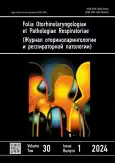A marker of proliferative activity Ki-67 in assessing the regeneration of the ciliated epithelium after a nasal injury in an experiment
- Authors: Berest I.Y.1
-
Affiliations:
- Saint Luke Lugansk State Medical University
- Issue: Vol 30, No 1 (2024)
- Pages: 51-58
- Section: Original study
- Submitted: 26.02.2024
- URL: https://journals.eco-vector.com/2310-3825/article/view/627499
- DOI: https://doi.org/10.33848/fopr627499
- ID: 627499
Cite item
Abstract
BACKGROUND: Nasal mucosa inflammation in response to surgical trauma is characterized by the development of alternative–dystrophic, vascular–exudative, and proliferative reactions. Immunohistochemical detection of Ki-67 protein expression is one of the most widely used methods for quantifying proliferative activity.
AIM: This study aimed to quantify the proliferative activity of epithelial cells after nasal cavity injury in an experiment under regenerative therapy.
MATERIALS AND METHODS: A preclinical randomized experimental study was conducted on 480 white male rats after experimental rhinitis modeling. The animals were divided into six groups depending on the prescribed regenerative therapy (0.25% solution of sodium deoxyribonucleate, dexpanthenol, and sodium hyaluronate).
RESULTS: After trauma induction, the specific weight of the proliferating epithelial cells in the mucous membrane of the nasal cavity increased from days 10 to 30 of observation. In groups that received reparants, the proliferative activity of cells increased from day 5 and persisted until days 42–60, the number of proliferating cells did not increase, and no carcinogenic effect was observed. Sodium deoxyribonucleate and dexpanthenol had a more pronounced proliferative effect.
CONCLUSIONS: The immunohistochemical determination of the proliferation marker of the nonhistone protein Ki-67, expressed in all cells during preparation and mitosis, appears relevant and allows its use as a universal marker of proliferating cells. Quantitative assessment of the changes in the proliferative activity of epithelial cells is relevant because it allows for the evaluation of the effectiveness and safety of regenerative therapy.
Keywords
Full Text
About the authors
Iryna Yе. Berest
Saint Luke Lugansk State Medical University
Author for correspondence.
Email: i_berest@mail.ru
ORCID iD: 0000-0003-1694-341X
SPIN-code: 3837-3276
MD, Cand. Sci. (Medicine)
Russian Federation, LuganskReferences
- Serebrennikova SN, Seminsky IZh, Guzovskaiia EV, Gutsol LO. Inflammation as a fundamental pathological process: lecture 1 (alteration, vascular reactions). Baikal Medical Journal. 2023;2(2):53–64. EDN: BOFHTN doi: 10.57256/2949-0715-2023-2-53-64
- Shehter AB, Serov VV. Inflammation, adaptive regeneration and dysregeneration (intercellular interaction analysis). Arhiv patologii. 1991;53(7):7–14. (In Russ.)
- Postalci L, Erdim I, Demirgil B, et al. Postoperative rhinological complications after microscopic transnasal hypophysectomy. Turk Neurosurg. 2017;27(2):182–186. doi: 10.5137/1019-5149.JTN.15754-15.1
- Karpishhenko SA, Vereshhagina OE, Teplova EO. Surgical treatment of nasal synechiae. Folia otorhinolaryngologiae et pathologiae respiratoriae. 2022;3(28):41–47. EDN: YLYAZI doi: 10.33848/foliorl23103825-2022-28-3-41-47
- Kushnarev VA, Artemyeva ES, Kudaybergenova AG. Comparison of digital and visual methods for Ki-67 assessment in invasive breast carcinomas. Arkhiv Patologii. 2018;80(2):38-42. EDN: UPOKBE doi: 10.17116/patol201880238-42
- Feng M, Deng Y, Yang L, et al. Automated quantitative analysis of Ki-67 staining and HE images recognition and registration based on whole tissue sections in breast carcinoma. Diagn Pathol. 2020;15(1):65. doi: 10.1186/s13000-020-00957-5
- Korshunova IA, Babichenko II, Popadjuk VI, Tepsaeva MJu. Proliferative activity of neoplastic transformation of the mucous membrane of the nasal cavity and paranasal sinuses. Zdorov’e i obrazovanie v XXI veke. 2011;13(2):265. (In Russ.) EDN: SBXREL
- Telezhnikova IM, Setdikova GR, Eremeeva ER, et al. Prognostic and predictive significance of the Ki67 marker in breast cancer. Malignant tumours. 2022;12(3S1):27–38. EDN: SHNFBK doi: 10.18027/2224-5057-2022-12-3s1-27-38
- Fong E, Garcia М, Woods СМ, Ooi Е. Hyaluronic acid for post sinus surgery care: systematic review and meta-analysis. J Laryngol Otol. 2017;131(S1):2–11. doi: 10.1017/S0022215116009269
- Cyplakov D, Mosihin S, Lopatin A. Ultrastructural characteristics of the maxillary sinus mucosa in experimental sinusitis in the dynamics of treatment with xymedon. Russian rhinology. 2007;(1):8–14. EDN: HZQVBJ
- Kobyljanskij VI. Mucociliary system: fundamental and applied aspects. Moscow: BINOM; 2008. 416 p. (In Russ.). EDN: QLRVNV
- Berest IE, Tananakina TP, Teleshova OV, et al. Evaluating the developed model of experimental rhinitis in laboratory rats: pre-clinical experimental randomized study. Kuban scientific medical bulletin. 2023;30(1):78–87. EDN: CNBIOC doi: 10.25207/1608-6228-2023-30-1-78-87
- Berest IE, Tananakina TP, Teleshova OV, et al. Estimation of the method of extraction the ciliated epithelium of the nasal septum in laboratory rats. Krymskii zhurnal ehksperimental’noi i klinicheskoi meditsiny. 2022;12(2):13–20. EDN: MBYOYA doi: 10.29039/2224-6444-2022-12-2-13-20
- Budjakov SV. Immunocorrective efficacy of Derinat in case of maxillary sinusitis. Nauchnye vedomosti BelGU Serija Medicina. Farmacija. 2010;22(93):130–136. (In Russ.) EDN: TJLYZL
- Balakireva EA, Bugrimov DJu, Filatov OJu, et al. Immunomodulatory and reparative therapy of influenza and acute respiratory infections in children. Lechaschy Vrach. 2015;6:15. (In Russ.) EDN: TVYCZN
- Zuikova AA, Bugrimov DYu, Krasnorutskaya ON, Kotova YuA. Practical experience in the application of rehabilitation programs for patients after COVID-19 in the conditions outpatient medical organizations. Lechaschy Vrach. 2020;12(23):72–79. (In Russ.). EDN: YUAUEP doi: 10.26295/OS.2020.19.74.014
- Boucher WS, Letourneau R, Huang M, et al. Intravesical sodium hyaluronate inhibits the rat urinary mast cell mediator increase triggered by acute immobilization stress. J Urol. 2002;167(1):380–384.
- Prosdocimi M, Bevilacqua C. Exogenous hyaluronic acid and wound healing: an updated vision. Panminerva Med. 2012;54(2):129–135.
- Karvinen S, Pasonen-Seppanen S, Hyttinen M, et al. Keratinocyte growth factor stimulates migration and hya1uronan synthesis in the epidermis by activation ofkeratinocyte hyaluronan synthases 2 and 3.1. BioI Chern. 2003;278(49):49495–49504. doi: 10.1074/jbc.M310445200
- Karpishchenko SA, Stancheva OA. New trends in the treatment of chronic rhinitis. Effective pharmacotherapy. 2019;15(30):22–25. EDN: RVEGNL doi: 10.33978/2307-3586-2019-15-30-22-25
- Kunel’skaja NL, Carapkin GJu, Artem’ev ME, et al. Conservative treatment of chemical damage of the nasal mucosa. Medicinskij sovet. 2013;3:63–64. (In Russ.)
- Behr W, Li H, Birk R, et al. Impact of Bepanthen® and dexpanthenol on human nasal ciliary beat frequency in vitro. Eur Arch Otorhinolaryngol. 2023;280:3731–3736. doi: 10.1007/s00405-023-07916-y
- Karpishhenko SA, Lavrenova GV, Kulikova O. Rhinitis sicca anterior. Vrach. 2017;11:66–68. EDN: ZVPYWR
Supplementary files













